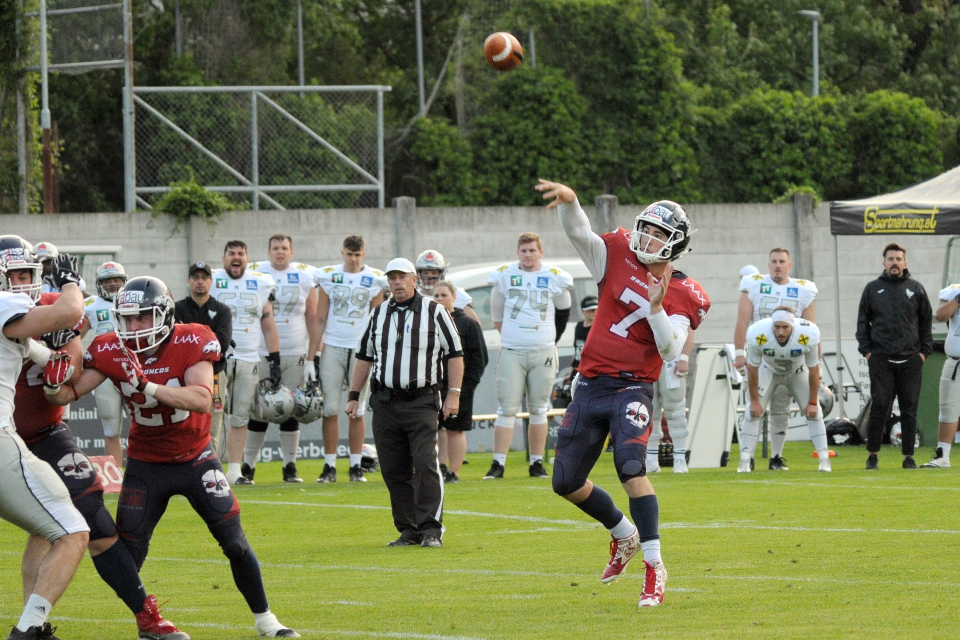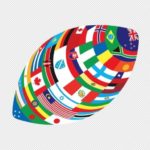For the second straight year, the defending champion Calanda Broncos and the Geneva Seahawks will square off in Switzerland’s championship game, Swiss Bowl XXXIV.
The head coach of the Bern Grizzlies, Wayne Jacobs, has kindly offered to provide his expert analysis of the game. He knows both teams extremely well. He and his team faced Calanda and Geneva a total of four times so there is no one better qualified to offer an analysis of the game.
By Wayne Jacobs
After a season that saw plenty of surprises, Swiss Bowl XXXIV involves a couple of familiar foes. For the second year in a row, the Geneva Seahawks will take on the Calanda Broncos for bragging rights and top crown in Swiss football. Last year’s meeting between the two was a rather lopsided 44-12 blowout by the Broncos, but 2019 is a new season and Sunday’s battle has the makings of a classic.
The Broncos, winners of seven of the last ten Swiss Championships, will be looking for a three peat as they host this year’s final and will be the favorite heading, but how much of a favorite is up for debate. The two teams split their regular season and finished first and second in the standings, but there is little doubt the gap has closed. In a classic matchup of contrasting styles, the 9-1 “ground and pound” Broncos will take on the 8-2 “air it out” Seahawks. Now don’t get me wrong, the Broncos can throw it with the best of them and Geneva definitely has the running game to dominate on the ground, but at the end of the day the winner of this one will likely be the team that takes the other out of their wheelhouse.

Calanda QB Conner Manning Photo: Sergio Brunetti
In what will be the key match-up of the day the Broncos offense will look to use power and strength against a Geneva defense that can fly. With arguably one of the best offensive lines in Europe the Broncos feature a two headed beast on the ground in the form of running backs Tino Muggwyler and Steffan Haenelt. A true “thunder and lightning” combo, Muggwyler provides laser quickness, at home slashing between the tackles or turning the corners; while Haenelt is the prototype “three yards and a cloud of dust” back. Running behind a big and nasty offensive line featuring Bastian Pereira, Jan Henrik Bogan, Michel Derungs and Andre Mathes, the Broncos have been a model of consistency in their ability to wear down the opponent and dominate the ground.
The one team that did have success this year in shutting down the Calanda ground game was this Seahawks team and the Geneva front seven, which features speed and skill, and will be the key again in this Swiss Bowl. Defensive End Cedric Vuagniaux, leads a defensive line that is predicated on speed. Vuaginaux is a speed rusher, with a non-stop motor and should factor big in the Calanda game planning. He’s a smart football player that can read the O-line, make plays up and down the line and has a motor that doesn’t quit. The Seahawks linebackers feature two top level player in Franck Glavin and Phil Reding, both can fly to the ball, and Glavin features DB type speed making plays from sideline to sideline. Reding is more the prototypical inside backer, who likes to fill against the run but has good speed and will be a factor.
The Seahawks secondary is led by American Cloves Campbell at safety and corner Wilson Idemudia, who has evolved this year as a premier corner. Rounded out by corner Chris Noah and safety Jonathan Vacas, this is a very aggressive group, good on run support and they communicate very well….and they will have to. The Broncos known for their ground game feature top receivers in Adrian Sunderhof and Lukas Lutshcher and have the QB to get them the ball.
Quarterback Connor Manning, showed his value leading the offense and Broncos to a 9-1 season and it was no accident. Manning a Georgia State product, showed why he was an NCAA Div 1 starter all season with deadly accuracy and incredible poise under pressure. One of the most accurate passers in Europe, Manning methodically picked apart teams and although not a runner, he has an uncanny ability to escape pocket pressure and a pocket sense second to none.
With as much focus paid on the aforementioned battles, we would be remiss if we didn’t take a look at the other side of the ball for both these championship contenders. Offensively Geneva was a fairly well balanced pass first offense, which threw the ball on 60% of their snaps this year, but showed the ability to finish games and run out the clock by running the ball. Feature back Morgan Nkule is a north/south runner who has good moves and the ability to cutback. With very good balance, Nkule is tough to bring down and Calanda has to have a swarming mentality to contend with him. A true dual threat, look for Nkule to become more of factor in the pass game than in the first two meetings, particularly when Geneva gets deep in Bronco territory.
Geneva WR Mateo Horber Photo: Sergio Brunetti
Charged with shutting down the run for defensive co-ordinator Nicolay Knutsen’s defense will be a Bronco front seven led by defensive linemen James Canetti, Simon Gavanda and of course the teams emotional leader linebacker Marco Mahrer. Mahrer the heart and soul of the front is a fleet footed linebacker who can run and likes to mix it up physically. Equally adept in pass coverage and versus the run, he’s also served as a steadying presence for a linebacking crew that has seen many looks this year. Another key player in the box for the Broncos will be linebacker Kai Takahashi. Much like Mahrer, Takahashi can run and hit, and has been consistent all year for Calanda.
The Broncos secondary has been bolstered with the late season addition of speedy Max Gray. Gray has helped solidify a Bronco secondary, that looked a little shaky early on in 2019, but is now playing some very solid football. Corner Matthias Tanno a member of the national team has quietly factored large for this secondary and safety Dea Baumann looms big for a group, that much like their Geneva counterparts plays a physical brand of football. The key for them this weekend will be in their ability to slow down and re-route a very talented and fast group of Seahawk receivers.
Leading the way for that group is the very talented and explosive Kevin Saibou. Saibou is quick off the line and has the speed to run past anybody he encounters. Not the most physical receiver, the Broncos will face the dilemma as to press him and risk him running by you, or to allow him to gain momentum and run by you….not a great set of options. Complimenting Saibou is Mateo Horber, who has been an absolute nightmare for defensive secondaries, particularly after the catch. With good hands and quickness, Horber really becomes problematic with his ability to turn 6 yard catches into 50 yard gamebreakers. At home in the slot position, Horber is a match-up problem and if Calanda isn’t able to get physical with him….look out. Complementing the quickness and speed of Saibu and Horber is Christopher Daizell, who although he doesn’t possess the speed of the previous two is a physical, possession type receiver. Not afraid to catch in traffic Daizell’s also a great run blocker and adds another dimension to this group.
A very evenly matched battle this year’s Swiss Bowl will come down to a few key match-ups and contrasting styles. Will the Geneva front seven neutralize the Broncos ground game with their speed? Can the talented Broncos secondary slow down the Geneva receivers? How will the Geneva secondary do against Manning? Not to mention, we haven’t even gotten into special teams! These and many other questions will be answered this Saturday in Chur, in a game that has all the makings of a classic.


